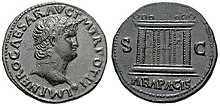As(Roman coin)
This articleneeds additional citations forverification.(November 2008) |

Theas(pl.:assēs), occasionallyassarius(pl.:assarii,rendered intoGreekasἀσσάριον,assárion),[1]was abronze,and latercopper,coinused during theRoman RepublicandRoman Empire.
Republican era coinage
[edit]The Romans replaced the usage of Greek coins, first by bronze ingots, then by disks known as theaes rude.[2]The system thus namedaswas introduced in ca. 280 BC as a largecastbronze coin during the Roman Republic. The following fractions of theaswere also produced: thebes(2⁄3),semis(1⁄2),quincunx(5⁄12),triens(1⁄3),quadrans(1⁄4),sextans(1⁄6),uncia(1⁄12,also a common weight unit), andsemuncia(1⁄24), as well as multiples of theas,thedupondius(2),sestertius(21⁄2), andtressis(3).

After theashad been issued as a cast coin for about seventy years, and its weight had been reduced in several stages, asextantalaswas introduced (meaning that it weighed one-sixth of a pound). At about the same time a silver coin, thedenarius,was also introduced. Earlier Roman silver coins had been struck on the Greek weight standards that facilitated their use in southern Italy and across the Adriatic, but all Roman coins were now on a Roman weight standard. Thedenarius,or 'tenner', was at first tariffed at tenassēs,but in about 140 BC it was retariffed at sixteenassēs.This is said to have been a result of financing thePunic Wars.
During the Republic, theasfeatured the bust ofJanuson the obverse, and the prow of agalleyon the reverse. Theaswas originally produced on thelibraland then the reduced libral weight standard. As the weight decreased, the bronze coinage of the Republic switched from being cast to being struck. During certain periods, noasses were produced at all.
Imperial era coinage
[edit]
Following thecoinage reform of Augustusin 23 BC, theaswas struck in reddish pure copper (instead of bronze), and thesestertiusor 'two-and-a-halfer' (originally 2.5asses, but now fourasses) and thedupondius(2asses) were produced in a golden-colored alloy of bronze known bynumismatistsasorichalcum.Theascontinued to be produced until the 3rd century AD. It was the lowest valued coin regularly issued during the Roman Empire, with semis andquadransbeing produced infrequently, and then not at all sometime after the reign ofMarcus Aurelius.The lastasseems to have been produced byAurelianbetween 270 and 275 and at the beginning of the reign of Diocletian.[3]
Byzantine coinage
[edit]Theas,under its Greek nameassarion,was re-established by the EmperorAndronikos II Palaiologos(r. 1282–1328) and minted in great quantities in the first half of the 14th century. It was a low-quality flat copper coin, weighing ca. 3–4gramsand forming the lowest denomination of contemporaryByzantine coinage,being exchanged at 1:768 to the goldhyperpyron.It appears that the designs on theassarionchanged annually, hence they display great variations. Theassarionwas replaced in 1367 by two other copper denominations, thetournesionand thefollaro.[1][4]
See also
[edit]References
[edit]- ^abKazhdan, Alexander,ed. (1991),Oxford Dictionary of Byzantium,Oxford University Press, p. 212,ISBN978-0-19-504652-6
- ^Pierre-François Puech."Deux As de Nimes au Musée d'Arles: A Roman Coin and the Myth of Anthony and Cleopatra | Pierre-François Puech".Academia.edu.Retrieved2014-06-07.
- ^"Aurelian Æ As. Rome mint. IMP AVRELIANVS AVG, laureate and cuirassed bust right / CONCORDIA AVG, Aurelian and Severina clasping hands, radiate bust of Sol, right, above them. RIC 80, Cohen 35. * Sear RCV [1988] s3276 *".Wildwinds. Archived fromthe originalon 2015-01-02.Retrieved2014-06-07.
- ^Grierson, Philip (1999),Byzantine coinage(PDF),Dumbarton Oaks, pp. 22, 45,ISBN978-0-88402-274-9,archived fromthe original(PDF)on 2010-06-13,retrieved2010-03-12
External links
[edit] Media related toAs (coin)at Wikimedia Commons
Media related toAs (coin)at Wikimedia Commons
